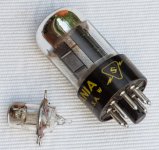Hi Friends,
Is there any physical requirement forcing makers to make the tubes so huge? Can they be miniaturized? Now adays there are mechanical parts inside microchips (gyros, accelerometers....) so why not tubes at the size of a 2000uF capacitor for example?
Does anyone knows?
Is there any physical requirement forcing makers to make the tubes so huge? Can they be miniaturized? Now adays there are mechanical parts inside microchips (gyros, accelerometers....) so why not tubes at the size of a 2000uF capacitor for example?
Does anyone knows?
Examine heat transfer equations. If this does not lead you to examine closely the radiation cooling one, I'll guide you there now. Take particular note of where area is used in the equations. This is in large part why a 12AU7 has a few Watts plate dissipation, and an 813 is well over 100. The temperature difference at a 4th power also shows why the yellow-orange hot Tantalum anodes are smaller for their dissipation ratings...yellow is a lot hotter than not-even-dull-red-yet.
Editing... 🙂 having written all that, I neglected the much smaller transmitting tubes that require forced air for convective cooling. Area plays a part there too, but with forced air driving up the convective coefficient 'h', the area can be smaller. These are usually 'exposed' anode structures, so to say, if you probe the outside of these tubes you'll find them electrically 'hot'.
cheers,
Douglas
cheers,
Douglas
Editing... 🙂 having written all that, I neglected the much smaller transmitting tubes that require forced air for convective cooling. Area plays a part there too, but with forced air driving up the convective coefficient 'h', the area can be smaller. These are usually 'exposed' anode structures, so to say, if you probe the outside of these tubes you'll find them electrically 'hot'.
cheers,
Douglas
cheers,
Douglas
Last edited:
Tubes can be miniaturised! Subminiature Tubes: The Future of Audio! - Effectrode
An externally hosted image should be here but it was not working when we last tested it.
There are some tubes the size of small capacitors. Look up the 6CW4. It was designed in 1959 for TV set tuners. As with all things, size is needed to radiate any heat generated. Tubes were on a "getting smaller with each generation" evolution, but most new vacuum tube design effort waned as they were replaced with solid state devices. There were some tiny little tubes made for use in missiles, hearing aids, and other small low powered things, but that development stopped when solid state became reliable tech.
Yes, there are new tubes being made today. Most of them are just copies of old designs, sometimes tweaked to reduce cost, or replace materials no longer available, or legal.
Yes, there are new tubes being made today. Most of them are just copies of old designs, sometimes tweaked to reduce cost, or replace materials no longer available, or legal.
Tubes can be miniaturised! Subminiature Tubes: The Future of Audio! - Effectrode
Thanks for the link. Why are them not in common use today in audio amplifiers?
It is actively being worked on. Transistor design goes back to the power of empty space | E&T Magazine
So we can say that it is because nobody is developing tubes technologies anymore? so in the near future solid state will replace tubes completely, finally?
It is actively being worked on. Transistor design goes back to the power of empty space | E&T Magazine
Interesting, but It probably won't be available for audio hobbyist any time soon 😀
Here's an interesting article on the construction and characteristics of Russian Subminiature Tubes: Russian Subminiature Tubes
Indra1 beat me to it! Vacuum tubes have an advantage over transistors when used in the radiation-harsh environment of space.
Enter 'nano tube technology' which doesn't even require the tubes to have a 'proper' vacuum!
Return of the Vacuum Tube | Science | AAAS
Indra1 beat me to it! Vacuum tubes have an advantage over transistors when used in the radiation-harsh environment of space.
Enter 'nano tube technology' which doesn't even require the tubes to have a 'proper' vacuum!
Return of the Vacuum Tube | Science | AAAS
Thanks for the link. Why are them not in common use today in audio amplifiers?
Back to the 'size/area' thing...is there any way to use these for heat generating output stages?
For the not power stage jobs, the usual signal amplifier tubes don't take much space, and designers are comfortable working with them...also, there is some purchaser expectation around what a tube amp should look like...those don't deliver...LOL
cheers,
Douglas
So we can say that it is because nobody is developing tubes technologies anymore? so in the near future solid state will replace tubes completely, finally?
Nothing endures in a flux of "hard" radiation, but tubes hold up longer than SS does.
Quite a few high powered radio/TV transmitters remain tubed, as heat sinking SS is problematic.
Last, but certainly not least, tubes are a DIYers "friend", when dealing with AF. Very high performance is comparatively easy to obtain. OTOH, top notch behavior from SS remains (AFAIK) the bailiwick of persons like John Curl and Nelson Pass.
there is some purchaser expectation around what a tube amp should look like...those don't deliver...LOL
cheers,
Douglas
LOL
In the early days, a basic computer occupes a small building, today we have computers one million times more powerful in the size of a nail. It is a shame we cannot build small SMD boards with top notch tube tecnologies.
Whatever happened to the cold-cathode electron emitter? I'd thought I had read something about this being a nano-tech, where arrays of electron-microscope sized spikes were created that could send electron off the tips - cold.
That might go some way toward miniaturization. Never heard about it again.
For a power tube - you could always stick an LED in the socket for simulated "glow" - with color that changes with the music. Something at least one Chinese manufacturer would do :')
That might go some way toward miniaturization. Never heard about it again.
For a power tube - you could always stick an LED in the socket for simulated "glow" - with color that changes with the music. Something at least one Chinese manufacturer would do :')
- Home
- Amplifiers
- Tubes / Valves
- Why are the tubes so huge?


